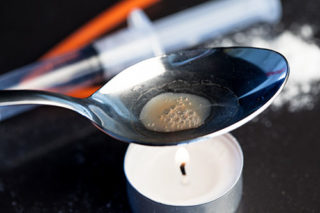Heroin is commonly called dope. When heroin is used, it binds with opioid receptors in the brain and it is highly addictive and dangerous. These receptors control the feelings of pain and pleasure and heart rate, sleeping, and breathing. Individuals who use this drug say they feel a “rush” or a stage of euphoria and pleasure. As individuals continue using use the drug, they can develop a tolerance, which means a person will increase their dosage to have the same effect as when they began using heroin.
Short-term effects of heroin include dry mouth, flushed feeling, arms and legs feeling heavy, nausea or vomiting, extreme itching, and clouded mental functioning. People often “nod,” which means going back and forth from states of consciousness to semi-consciousness. Long-term effects can include insomnia, depression, antisocial personality disorder, sexual dysfunction in men, irregular menstruation cycles in women, lung complications like pneumonia, liver and kidney disease, and constipation, stomach cramping, and abscesses. It can also cause infection of the heart lining and valves, which is called infective endocarditis and can be deadly.
Your path to recovery is waiting
and we’re here to help.
Our admissions specialist are available 24/7 to listen to your story
and get you started with next steps.
When you call our helpline, you will be connected with a caring admissions navigator to discuss your options for treatment.
Individuals who inject heroin may have collapsed veins, and individuals who snort or sniff heroin may have damaged tissue within the nose. This drug comes with numerous additives like sugar, powdered milk, starch, and fentanyl. These additives can clog blood vessels connected to the lungs, brain, liver, and kidneys, causing permanent damage. The risk of contracting infectious diseases like Hepatitis C and HIV increases due to impaired judgment and sharing of injecting equipment.
Heroin overdoses have been on the rise in the last several years. The increase in overdoses is also to fentanyl, which is added without a user’s knowledge. When an overdose occurs, breathing slows down or stops and can cause a decrease of oxygen reaching the brain, known as hypoxia. There can be long- or short-term effects on the nervous system as a result of hypoxia. Heroin overdose can also lead to coma or permanent brain damage.
Important Statistics on Heroin Use
- According to the National Survey on Drug Use and Health, since 2015, 5.1 million people have used heroin.
- Individuals between the ages of 18- 29 and ages 30-44 choose heroin as their drug of choice.
- 80% of those who misused prescribed opioid switch to heroin.
- Two-thirds of individuals who have undergone treatment, relapse.
Heroin Addiction and Heroin Withdrawal
If you believe someone is using heroin, it is important to note their physical characteristics and lifestyle habits. Heroin users may have paraphernalia, which can include needles, pipes, or spoons. Users often suffer from memory loss, confused thinking, and feelings of heaviness. They can also suffer from disorientation and have trouble making decisions.


